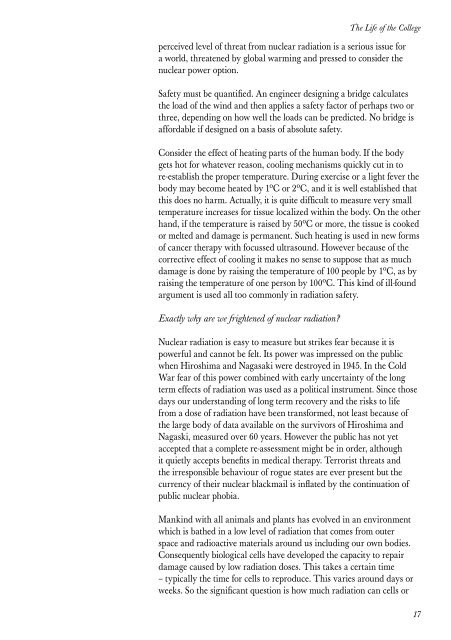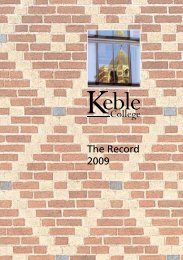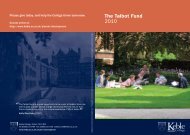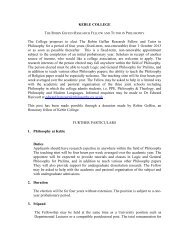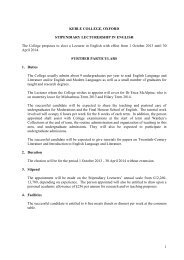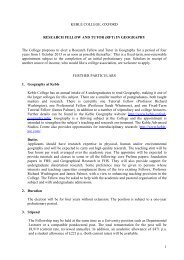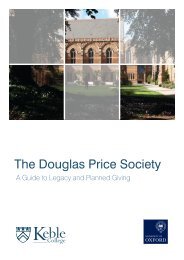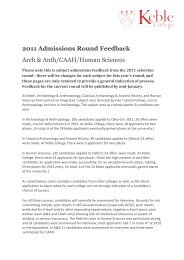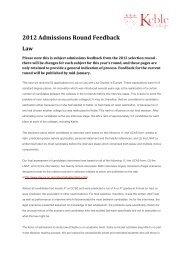The Record 2006 - Keble College - University of Oxford
The Record 2006 - Keble College - University of Oxford
The Record 2006 - Keble College - University of Oxford
You also want an ePaper? Increase the reach of your titles
YUMPU automatically turns print PDFs into web optimized ePapers that Google loves.
<strong>The</strong> Life <strong>of</strong> the <strong>College</strong><br />
perceived level <strong>of</strong> threat from nuclear radiation is a serious issue for<br />
a world, threatened by global warming and pressed to consider the<br />
nuclear power option.<br />
Safety must be quantified. An engineer designing a bridge calculates<br />
the load <strong>of</strong> the wind and then applies a safety factor <strong>of</strong> perhaps two or<br />
three, depending on how well the loads can be predicted. No bridge is<br />
affordable if designed on a basis <strong>of</strong> absolute safety.<br />
Consider the effect <strong>of</strong> heating parts <strong>of</strong> the human body. If the body<br />
gets hot for whatever reason, cooling mechanisms quickly cut in to<br />
re-establish the proper temperature. During exercise or a light fever the<br />
body may become heated by 1ºC or 2ºC, and it is well established that<br />
this does no harm. Actually, it is quite difficult to measure very small<br />
temperature increases for tissue localized within the body. On the other<br />
hand, if the temperature is raised by 50ºC or more, the tissue is cooked<br />
or melted and damage is permanent. Such heating is used in new forms<br />
<strong>of</strong> cancer therapy with focussed ultrasound. However because <strong>of</strong> the<br />
corrective effect <strong>of</strong> cooling it makes no sense to suppose that as much<br />
damage is done by raising the temperature <strong>of</strong> 100 people by 1ºC, as by<br />
raising the temperature <strong>of</strong> one person by 100ºC. This kind <strong>of</strong> ill-found<br />
argument is used all too commonly in radiation safety.<br />
Exactly why are we frightened <strong>of</strong> nuclear radiation?<br />
Nuclear radiation is easy to measure but strikes fear because it is<br />
powerful and cannot be felt. Its power was impressed on the public<br />
when Hiroshima and Nagasaki were destroyed in 1945. In the Cold<br />
War fear <strong>of</strong> this power combined with early uncertainty <strong>of</strong> the long<br />
term effects <strong>of</strong> radiation was used as a political instrument. Since those<br />
days our understanding <strong>of</strong> long term recovery and the risks to life<br />
from a dose <strong>of</strong> radiation have been transformed, not least because <strong>of</strong><br />
the large body <strong>of</strong> data available on the survivors <strong>of</strong> Hiroshima and<br />
Nagaski, measured over 60 years. However the public has not yet<br />
accepted that a complete re-assessment might be in order, although<br />
it quietly accepts benefits in medical therapy. Terrorist threats and<br />
the irresponsible behaviour <strong>of</strong> rogue states are ever present but the<br />
currency <strong>of</strong> their nuclear blackmail is inflated by the continuation <strong>of</strong><br />
public nuclear phobia.<br />
Mankind with all animals and plants has evolved in an environment<br />
which is bathed in a low level <strong>of</strong> radiation that comes from outer<br />
space and radioactive materials around us including our own bodies.<br />
Consequently biological cells have developed the capacity to repair<br />
damage caused by low radiation doses. This takes a certain time<br />
– typically the time for cells to reproduce. This varies around days or<br />
weeks. So the significant question is how much radiation can cells or<br />
17


